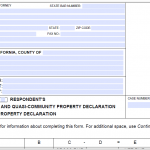FL 160 is the property declaration form which can be used for multiple purposes. You can fill this form by preparing a petition or response or you can use this form while you are declaring of disclosure.

If you are using FL 160 as an attachment to Declaration of Disclosure you have to fill columns A – E on pages 1, 2, and columns A – C on page 3.
We have already discussed how to fill the caption of a divorce form in FL-150 and FL-115. In FL 160 the caption is filling the same way as FL -150 and FL-115. You will need to put your name, your address, and telephone number, and which county in which you are filing. Below you will put your address of that court you are filing with and the branch name. For example, in Orange County, the brunch is Lamoureux Justice. Below is the petitioner’s name and the respondent’s name. The petitioner in the beginning of the case will always be the petitioner on all forms; same with the respondent.
In the next line FL 160 you need to mark whatever is applicable to you, whether you are a petitioner or respondent. You can use this form twice – for your community/quasi-community property with the first form and the second form for the separate property. Community property is the property acquired during the marriage. Quasi-community property is any type of property that was acquired by either one or both spouses or domestic partners when living in another state that, had it been acquired while living in California, it would have been considered community property.
The property declaration portion of FL 160 starts with real estate. In the first column, you need to place each property address. In the second the date it was acquired. Usually people Google the property address in order to estimate a fair value market. However frequently the appraisal value significantly deviates from the online value given in Zillow or Redfin. If you have no other choice and still need to get a value, you could use that value or you could ask some real estate agents in town or you can look at the prices for similar pieces of property in the neighborhood.
If you have multiple real estate properties, list them accordingly by market gross fair market value, amount you owe, and net value. If you are planning to keep one of the properties and you are the petitioner, place the net value in the petitioner column. If you are selling the property and dividing the proceed, place the amount you are keeping for yourself and your spouse in the columns for petitioners and respondent. As you can see on the second page, of FL-160, at the bottom a field for total assets which adding all of the numbers up for you. Therefore it is convenient to use FL-160 in many cases.
Let talk about the next section household furniture . The gross fair market value is the value you would get if you put it sold it at a garage sale. You don’t need to list every couch or table if nothing specific about it, but you can state assorted portion which goes to you and your spouse in correlated columns for petitioner and respondent. For example, your spouse will get 50% of the furniture in the house and all furniture value is 2000. You can placed $ 1000 for the petitioner and $1000 for the respondent.
Next is jewelry: if you gave your spouse a ring or a necklace or bracelets, or something similar – if it was a gift, you need to understand that’s her separate property so it is not going to be listed as community property. If you are filling the form for community property, you should not place those items in the form.
The next section FL 160 is vehicles In order to find out the value, you can get the value of the vehicles using trade-in value on Kelly Blue Book comp. The court use trade-in value at the courts most of the time because the courts know that if you drive your car to a dealer , they will pay at least a big portion of trade in value. Keep in mind, if you bought the car during the marriage, it is community property as well as the debt for the debt. Sometimes the net value of the car is less than the debt. If your spouse is taking a car and there is a debt on the car which is is higher than net value, you will need to mark the debt in negative number. You should place “- $2300”, for example if the different net value of the car 15000 and the debt is 17300.
In filling other sections FL 160 you can fill out the way similar as we have explained in the post FL-142.
If you have a business you should fill out the accounts receivables portion from the business you own, you need to put the value in appropriate columns.
The important information to know about FL 160 is California is a community property jurisdiction. The court has to divide your community property equally. That mean that if you are showing that significantly more property of total community assets is awarded to you or your spouse, that would not work well. You need to equalize the assets to you and your spouse as well as debt if you would like to avoid standing in front of a judge. The court would likely submit your judgment without you going to the court if you and your spouse divided and showed to the court that the division of the property is according to the law.
You can download FL-160 in the California Superior Court website
call 714-390-3766 for a free case evaluation

